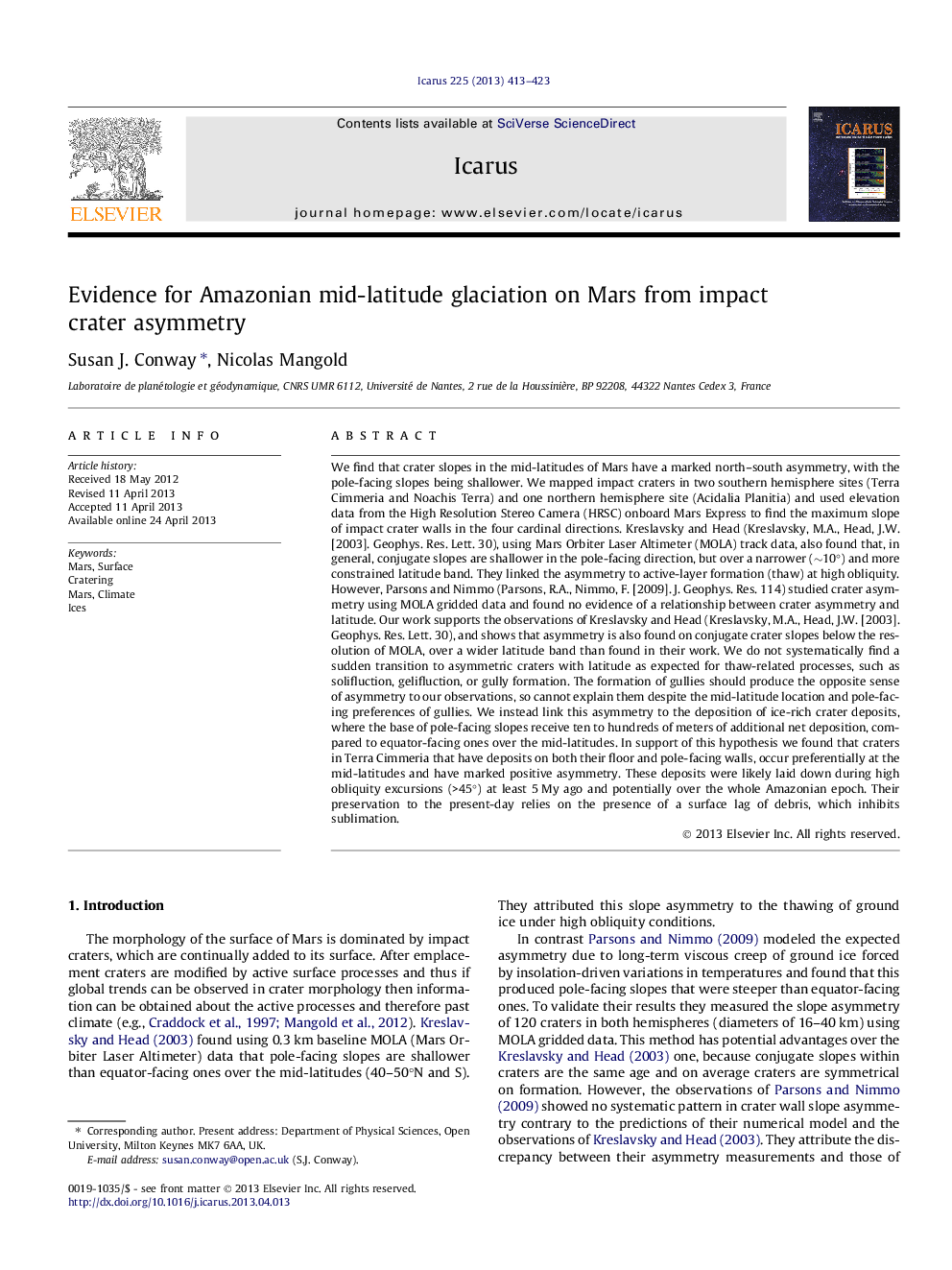| کد مقاله | کد نشریه | سال انتشار | مقاله انگلیسی | نسخه تمام متن |
|---|---|---|---|---|
| 1773216 | 1021122 | 2013 | 11 صفحه PDF | دانلود رایگان |
عنوان انگلیسی مقاله ISI
Evidence for Amazonian mid-latitude glaciation on Mars from impact crater asymmetry
دانلود مقاله + سفارش ترجمه
دانلود مقاله ISI انگلیسی
رایگان برای ایرانیان
موضوعات مرتبط
مهندسی و علوم پایه
علوم زمین و سیارات
علوم فضا و نجوم
پیش نمایش صفحه اول مقاله

چکیده انگلیسی
We find that crater slopes in the mid-latitudes of Mars have a marked north-south asymmetry, with the pole-facing slopes being shallower. We mapped impact craters in two southern hemisphere sites (Terra Cimmeria and Noachis Terra) and one northern hemisphere site (Acidalia Planitia) and used elevation data from the High Resolution Stereo Camera (HRSC) onboard Mars Express to find the maximum slope of impact crater walls in the four cardinal directions. Kreslavsky and Head (Kreslavsky, M.A., Head, J.W. [2003]. Geophys. Res. Lett. 30), using Mars Orbiter Laser Altimeter (MOLA) track data, also found that, in general, conjugate slopes are shallower in the pole-facing direction, but over a narrower (â¼10°) and more constrained latitude band. They linked the asymmetry to active-layer formation (thaw) at high obliquity. However, Parsons and Nimmo (Parsons, R.A., Nimmo, F. [2009]. J. Geophys. Res. 114) studied crater asymmetry using MOLA gridded data and found no evidence of a relationship between crater asymmetry and latitude. Our work supports the observations of Kreslavsky and Head (Kreslavsky, M.A., Head, J.W. [2003]. Geophys. Res. Lett. 30), and shows that asymmetry is also found on conjugate crater slopes below the resolution of MOLA, over a wider latitude band than found in their work. We do not systematically find a sudden transition to asymmetric craters with latitude as expected for thaw-related processes, such as solifluction, gelifluction, or gully formation. The formation of gullies should produce the opposite sense of asymmetry to our observations, so cannot explain them despite the mid-latitude location and pole-facing preferences of gullies. We instead link this asymmetry to the deposition of ice-rich crater deposits, where the base of pole-facing slopes receive ten to hundreds of meters of additional net deposition, compared to equator-facing ones over the mid-latitudes. In support of this hypothesis we found that craters in Terra Cimmeria that have deposits on both their floor and pole-facing walls, occur preferentially at the mid-latitudes and have marked positive asymmetry. These deposits were likely laid down during high obliquity excursions (>45°) at least 5 My ago and potentially over the whole Amazonian epoch. Their preservation to the present-day relies on the presence of a surface lag of debris, which inhibits sublimation.
ناشر
Database: Elsevier - ScienceDirect (ساینس دایرکت)
Journal: Icarus - Volume 225, Issue 1, July 2013, Pages 413-423
Journal: Icarus - Volume 225, Issue 1, July 2013, Pages 413-423
نویسندگان
Susan J. Conway, Nicolas Mangold,